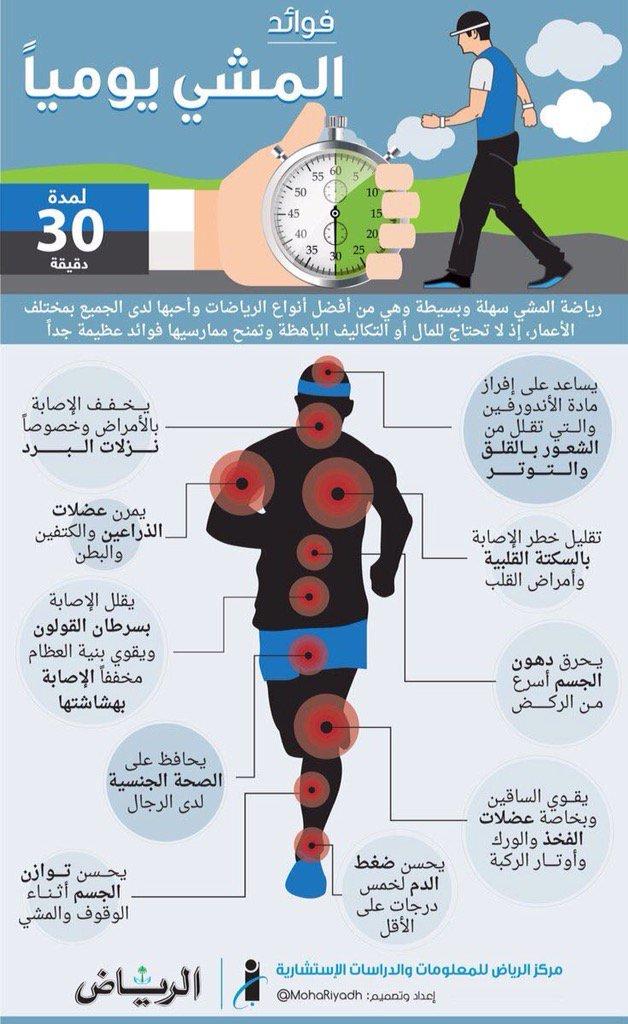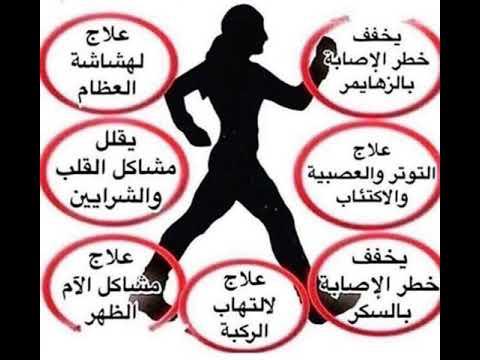Walking is one of the least expensive, simple and easiest physical activities and does not require any equipment or special skills. It is also a way to improve physical fitness, maintain health and reduce stress. Unfortunately, it did not receive the appreciation it deserves, whether in terms of health or its value as a means of transportation and entertainment. In the present era, we see that the more people develop, the less they practice it.
This sport can be practiced at any time and anywhere (such as parks, markets, public roads on the seaside, etc.) and is not limited to a certain age, even if the person is not able to exercise in general due to his health conditions, but walking will contribute to improving health and restoring activity, and can be made a part of everyday life.
While walking, all the muscles of the body move, starting from the muscles of the feet to the muscles of the arms.
It also increases blood flow to all parts of the body.
Burn extra calories.
Maintain a healthy weight and improve physical fitness.
Prevention of chronic diseases (such as: heart disease, high blood pressure, type 2 diabetes).
Helping reduce the level of harmful cholesterol in the body.
Promote bone health and prevent osteoporosis.
Reducing anxiety or depression and improving mood.
Maintain joint flexibility and muscle strength.
Improving balance and blood flow in the body.
The faster, longer, and more frequent walking, the greater its benefits.
It is recommended to walk for at least 30 minutes a day, and it is not required to walk for hours to get the benefits, but it is enough to walk for more than 10 minutes a day and gradually increase the duration until it reaches the recommended goal.
Because walking is less intense than jogging, it will take longer and more repetitions to reach the benefits of jogging. The American Heart Association recommends walking at least 30 minutes a day, five days a week (150 minutes a week), which is equivalent to jogging for 20 minutes a day for three days. per week.
Walking does not mean simply running slow, but the difference is more than that, as walking means that one foot remains on the ground - at least - alternately all the time, while during running, both feet rise in one of its stages (i.e., like jumping), and the higher the speed, the greater the length hops;
Climbing in general is an activity that is 50 percent more intense than normal walking or downward (descending) or weight-bearing, as a person reaches peak effort when climbing faster than normal walking, so the majority of people feel tired when going up to the upper floors On the other hand, calories burned faster when climbing stairs.
Because of the increased effort when climbing long distances, it is only recommended for those who have sufficient fitness to do it, but it is okay for everyone to do this for short distances, in a simple way and at a constant speed because of its additional benefits to health, but it is not recommended after eating a heavy meal or when feeling unwell.
Converting normal walking into a healthy walk requires standing in an appropriate position and performing certain meaningful movements as follows:
Lift the head, looking forward and not at the ground.
Relax the neck, shoulders and back and do not bend them forward.
Move the arms freely with a slight bend in the elbows, knowing that the movement of the arms comes from the shoulder and not from the elbow.
Tighten the abdominal muscles, taking care to straighten the back appropriately.
Taking into account the flexibility of the knee movement and not moving the leg and thigh together.
Walk smoothly, with the heel of the foot touching the ground first and then the toes.
Choose shoes that are suitable and supportive with a sturdy heel and a thick, flexible lining to absorb shock, and do not cause blistering of the skin.
If walking to work, it's OK to wear your usual work clothes, and wear comfortable, brightly colored clothes when walking outside at night.
Choosing the right place: If walking outside, it is advised to avoid bumpy roads with cracked sidewalks and potholes, and if the weather is not suitable for walking, it is recommended to go to places designated for walking such as markets.


If you are going for a long walk it is advised to bring some water, snacks, spare clothes, sunscreen and a hat to protect from the sun.
Warm-up: It means starting with a slow walk for five to ten minutes to warm up the muscles and prepare the body for sports.
Cooling: Ending the walk by slowing down for five to ten minutes, to relax the muscles.
Stretching exercises: Stretching exercises can be done after warming up or after cooling down.
Regulating the time of taking the treatment (insulin needles or medications).
Refrain from injecting insulin into the thigh muscle because exercise in general makes it absorb insulin very quickly.
Check your blood sugar level 15 minutes before and one hour after walking.
Avoid walking when you notice an unusual rise in blood sugar.
It is recommended for people who are prone to hypoglycemia to bring an ambulance person in case of emergency.
Organize meal times to avoid low blood sugar, as a person will remain prone to low at any moment for more than a day after walking.
Walking is a great way for asthma patients, as it helps the lungs expand and relax, and the following are recommended:
Use the inhaler at least half an hour before starting.
Take an emergency inhaler.
Make sure to warm up before walking.
Avoid walking in areas with polluted air (eg busy roads).
Cover your face with a scarf or fleece when the air is cold.
The walking space must be secured so that it is safe and the floor is flat and not strenuous, and any specific needs discussed before you start walking
Babies get bored easily and may need a little encouragement to keep walking. Here are some tips for them:
Focus on a destination that is interesting to them (eg a park, playground, etc.); Where you can walk freely.
Choose a zigzag path for them.
Take a camera and ask for their help to take pictures.
Encourage the child to invite a friend to join him in walking.
Provide healthy snacks and drinks, and when signs of fatigue appear on the child, he must take a break.
Stop if you feel dizzy, very tired, or have difficulty breathing.
Walking under the sun should be avoided.
Avoid walking unaccompanied when suffering from chronic diseases.
Pay attention to the road while walking to avoid falling.
Avoid eating during or immediately after walking to avoid disturbances in the digestive process.
Drink water constantly and in batches during and after walking.
The correct walk means that you travel 3 miles per hour (a mile is equivalent to 1,600 meters, or approximately one and a half kilometres), and it means jogging, not hiking, and smart device applications can be used to calculate the distance traveled.
Park the car further away and walk the path.
Walking with friends.
Hiking with family and friends.
Go out for a walk during work breaks instead of wasting all your time sitting.
Use the stairs instead of the elevators.
Going for a walk to pick up the kids from school.
Listen to audio clips to forget the effort of walking.
Setting a specific goal and making sure to reach it and follow the level of improvement by walking.
Using smart device applications for encouragement and follow-up.
Change the location frequently, and use different methods if walking outside.
Does walking on a treadmill have the same effect as walking outdoors?
They are similar in terms of effect and effect.
Tags heart disease, chronic disease, physical activity, depression, stress, body, exercise, calories, child health, LDL cholesterol, fitness, american heart association, burning calories, walking, blood pressure, body muscles, the elderly, osteoporosis